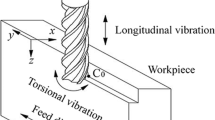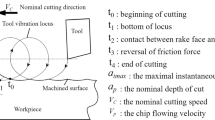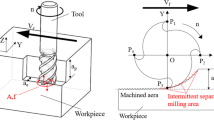Abstract
In order to solve the problems of poor machining accuracy and surface quality of hard and brittle materials such as Ti2AlNb intermetallic alloy in conventional machining, the principle of apparent elasticity method was used to design a flat-plate vibration device. Firstly, the propagation characteristics of ultrasonic in inclined slot plate were analyzed by using the propagation law of acoustic wave in different media. Secondly, the vibration characteristics were analyzed and discussed in detail by using finite element software. Finally, the influence of the vibration characteristics of vibration platform on the cutting performance of Ti2AlNb alloy was studied through ultrasonic vibration cutting and common cutting (CC) experiments. The finite element modelling (FEM) and test results showed that when the slot width was 2 mm and the inclination angle was 45°, the vibration effect of the plate vibration device was the best, and the vertical upward vibration component was generated at the workpiece installation area of the plate. The errors between the measured frequency and the results of theoretical calculation and finite element analysis were 1.78% and 0.36%, respectively, which showed the reliability of finite element simulation. Compared with the three-dimensional ultrasonic vibration cutting (3DUVC) and CC, the results of two-dimensional ultrasonic vibration cutting (2DUVC) based on flat-plate vibration device showed an obvious “drainage tank” microstructure in variable speed cutting; when the rotating speed was 1700 r/min, the roughness value of 2DUVC was 54% and 57% lower than that of 3DUVC and CC, respectively. The amplitude along the feed direction was 8 μm, the surface roughness of 2DUVC decreased by 64% and 65.9%, respectively, compared with 3DUVC and CC. The number of chip sawtooth increased with the increase of ultrasonic amplitude and vibration dimension. The experimental results showed that for Ti2AlNb alloy, ultrasonic vibration cutting can obtain higher surface quality, and the two-dimensional ultrasonic vibration platform was helpful to improve the cutting performance of materials, and the 3DUVC can realize the rapid removal of materials.




























Similar content being viewed by others
Availability of data and materials
The datasets used or analyzed during the current study are available from the corresponding author on reasonable request.
Change history
13 September 2022
A Correction to this paper has been published: https://doi.org/10.1007/s00170-022-10130-5
References
Zhang HY, Yan N, Liang HY et al (2021) Phase transformation and microstructure control of Ti2AlNb-based alloys: a review. J Mater Sci Technol 80:203–216. https://doi.org/10.1016/j.jmst.2020.11.022
He LJ, Su HH, Xu JH et al (2018) Inverse identification of constitutive parameters of Ti 2 AlNb intermetallic alloys based on cooperative particle swarm optimization. Chin J Aeronaut 31(8):1774–1785. https://doi.org/10.1016/j.cja.2018.01.002
Sim KH, Zhang F, Wang G et al (2017) Experimental comparison of ground surface characteristics for P/M Ti2AlNb-based alloy using CBN and diamond grinding wheels. Int J Adv Manuf Technol. https://doi.org/10.1007/s00170-017-0900-2
Ma XD, Xu JH, Ding WF et al (2013) Wear behavior of Ti(N, C)-Al2O3 coated cemented carbide tools during milling Ti2AlNb-based alloy. Key Eng Mater 589–590:361–365. https://doi.org/10.4028/www.scientific.net/KEM.589-590.361
Gao GF, Yuan ZJ, **a ZW et al (2021) Study on thrust force of ultrasonic-assisted vibration micro-hole drilling of titanium alloy. Int J Adv Manuf Technol 112(11):3399–3413. https://doi.org/10.1007/s00170-021-06588-4
Li ZC, Jiao Y, Deines TW et al (2005) Rotary ultrasonic machining of ceramic matrix composites: feasibility study and designed experiments. Int J Mach Tools Manuf 45(12–13):1402–1411. https://doi.org/10.1016/j.ijmachtools.2005.01.034
He YH, Wan RQ, Zhou JJ et al (2017) Modeling forsurface roughness of hard and brittle materials in axial ultrasonic vibration grinding. J Vib Shock 36(23):194–200. https://doi.org/10.13465/j.cnki.jvs.2017.23.029
Cao Y, Yin JF, Ding WF et al (2021) Alumina abrasive wheel wear in ultrasonic vibration-assisted creep-feed grinding of Inconel 718 nickel-based superalloy. J Mater Process Technol 297:117241. https://doi.org/10.1016/j.jmatprotec.2021.117241
Lin SY (2002) Study on the prestressed sandwich piezoelectric ceramic ultrasonic transducer of torsional-flexural composite vibrational mode. J Acoust Soc Am 112(2):511–517. https://doi.org/10.1121/1.1492819
Gao GF, **a ZW, Yuan ZJ et al (2021) Influence of longitudinal-torsional ultrasonic-assisted vibration on micro-hole drilling Ti-6Al-4V. Chin J Aeronaut 34(9):247–260. https://doi.org/10.1016/j.cja.2020.06.012
Chang BQ, Zhao B, Yuan LS et al (2019) Influence of force load on ultrasonic longitudinal-torsional composite drilling system. J Vib Meas Diagnosis 39(05):1111–1119. https://doi.org/10.16450/j.cnki.issn.1004-6801.2019.05.029
Qian XH, Shen MH (2011) A new standing-wave linear moving ultrasonic motor based on two bending modes. Appl Mech Mater 101–102:140–143. https://doi.org/10.4028/www.scientific.net/AMM.101-102.140
Yuan LS, Zhao B, Wang Y et al (2020) Surface micro-texture characteristics of 7075 aluminum alloys by elliptical vibration assisted turning. China Mech Eng 31(15):1831–1838. https://doi.org/10.3969/j.issn.1004-132X.2020.15.010
Zhao B, Bie WB, Wang XB et al (2019) The effects of thermo-mechanical load on the vibrational characteristics of ultrasonic vibration system. Ultrasonics 98:7–14. https://doi.org/10.1016/j.ultras.2019.05.005
Zhao B, Guo XC, Bie WB et al (2020) Thermo-mechanical coupling effect on surface residual stress during ultrasonic vibration-assisted forming grinding gear. J Manuf Process 59:19–32. https://doi.org/10.1016/j.jmapro.2020.09.041
Li JJ, Cheng CJ (2005) Differential quadrature method for nonlinear vibration of orthotropic plates with finite deformation and transverse shear effect. J Sound Vib 281(1–2):295–309. https://doi.org/10.1016/j.jsv.2004.01.016
Qu YG, Long XH, Yuan GQ et al (2013) A unified formulation for vibration analysis of functionally graded shells of revolution with arbitrary boundary conditions. Compos Part B-Eng 50:381–402. https://doi.org/10.1016/j.compositesb.2013.02.028
Wang QS, Shi DY, Shi XJ (2016) A modified solution for the free vibration analysis of moderately thick orthotropic rectangular plates with general boundary conditions, internal line supports and resting on elastic foundation. Meccanica 51(8):1985–2017. https://doi.org/10.1007/s11012-015-0345-3
Li WL (2004) Vibration analysis of rectangular plates with general elastic boundary supports. J Vib Shock 273(3):619–635. https://doi.org/10.1016/S0022-460X(03)00562-5
Li GR, Wang L, Hu CB et al (2020) Analysis of transverse vibration characteristics for stiffened rectangular plates with classical boundary conditions. J Vib Shock 39(16):261–266. https://doi.org/10.13465/j.cnki.jvs.2020.16.035
Du F, Ma TB et al (2017) Study on new method for modal parameters identification of stiffened plate with four clamped edges. Vib Procedia 14. https://doi.org/10.21595/vp.2017.18972
Paula Macanhan VB, Correa EO, de Lima AMG et al (2019) Vibration response analysis on stainless steel thin plate weldments. Int J Adv Manuf Technol 102(5–8):1779–1786. https://doi.org/10.1007/s00170-019-03297-x
Selicani GV, Buiochi F (2021) Stepped-plate ultrasonic transducer used as a source of harmonic radiation force optimized by genetic algorithm. Ultrasonics 116. https://doi.org/10.1016/j.ultras.2021.106505
Wang RH, Han Q, Li PJ et al (2012) Geometrically nonlinear free vibration and internal resonance of a stiffened plate with four edges simply supported. J Vib Shock 31(24):60–64. https://doi.org/10.13465/j.cnki.jvs.2012.24.001
Podymova NB, Karabutov AA (2021) Transformation of laser-induced broadband pulses of longitudinal ultrasonic waves into pulses of shear waves in an isotropic solid plate immersed in a liquid. Ultrasonics 116. https://doi.org/10.1016/j.ultras.2021.106517
Heikkola E, Laitinen M (2005) Model-based optimization of ultrasonic transducers. Ultrason Sonochem 12(1):53–57. https://doi.org/10.1016/j.ultsonch.2004.05.009
Piao C, Kim JO (2016) Vibration characteristics of a piezoelectric disk laminated with an elastic disk. J Mech Sci Technol 30(12):5351–5362. https://doi.org/10.1007/s12206-016-1102-9
Iula A, Vazquez F, Pappalardo M et al (2002) Finite element three-dimensional analysis of the vibrational behaviour of the Langevin-type transducer. Ultrasonics 40(1):513–517. https://doi.org/10.1016/S0041-624X(02)00174-9
Lin S, Xu L, Wen XH (2011) A new type of high power composite ultrasonic transducer. J Sound Vib 330(7):1419–1431. https://doi.org/10.1016/j.jsv.2010.10.009
Xu L, Lin S, Hu W (2011) Optimization design of high power ultrasonic circular ring radiator in coupled vibration. Ultrasonics 51(7). https://doi.org/10.1016/j.ultras.2011.03.010
Yin S, Zhao B, Li Y (2019) Design of a mode conversion type longitudinal-torsional composite ultrasonic vibration machining system. J Vib Shock 38(11):242–248. https://doi.org/10.13465/j.cnki.jvs.2019.11.035
Jun Pi (2008) Longitudinal-torsional vibration converter of cylinder with multiple diagonal slits. J Mech Eng 05:242–248. https://doi.org/10.3321/j.issn:0577-6686.2008.05.041
Lin SY, Zhang FC (1992) A study of large dimension vibrating systems and their transverse sloting. Technical Acoustics 04:24–28. http://sxjs.cnjournals.cn/ch/reader/view_abstract.aspx?file_no=19920407&flag=1
Lin ZM, Lu JH (1996) Analysis of ultrasonic horn for plastic welding by finite element method. Technical Acoustics 04: 153–156. http://sxjs.cnjournals.cn/ch/reader/view_abstract.aspx?file_no=19920407&flag=1
Lu X, Hu J, Peng H et al (2017) A new topological structure for the Langevin-type ultrasonic transducer. Ultrasonics 75:1–8. https://doi.org/10.1016/j.ultras.2016.11.008
Gao J, Lin SY (2009) Study on the oblique wedge-like transformer with a large dimension rectangular gradual section. J Shaanxi Norm Univ (Nat Sci Ed) 37(05):42–44. https://doi.org/10.1360/972008-2465
Xu L, Qiu X, Zhou J et al (2018) A 2D dual-mode composite ultrasonic transducer excited by a single piezoceramic stack. Smart Mater Struct. https://doi.org/10.1088/1361-665X/aaf275
Azarhoushang B, Tawakoli T (2011) Development of a novel ultrasonic unit for grinding of ceramic matrix composites. Int J Adv Manuf Technol 57(9):945. https://doi.org/10.1007/s00170-011-3347-x
Han GC, Sun Y, Sun M et al (2014) Design and simulation for a porous rectangular block ultrasonic horn. J Vib Shock 33(19):211–217. https://doi.org/10.13465/j.cnki.jvs.2014.19.036
Zhou GP, Liang MJ, Wang JX (2004) Study on large sized ultrasonic vibrators. Tech Acoust 03:183–188. https://doi.org/10.3969/j.issn.1000-3630.2004.03.012
**an XJ, Lin SY (2008) Study on the multi-frequency piezoelectric ultrasonic transducer with arectangular radiator. J Appl Acoust 03:234–238. https://doi.org/10.3969/j.issn.1000-310X.2008.03.013
Bruzzone AAG, Costa HL, Lonardo PM et al (2008) Advances in engineered surfaces for functional performance. CIRP Ann 57(2):750–769. https://doi.org/10.1016/j.cirp.2008.09.003
Li J, **ong D, Dai J et al (2010) Effect of surface laser texture on friction properties of nickel-based composite. Tribol Int 43(5–6):1193–1199. https://doi.org/10.1016/j.triboint.2009.12.044
**ng D, Zhang J, Shen X et al (2013) Tribological properties of ultrasonic vibration assisted milling aluminium alloy surfaces. Procedia CIRP 6:539–544. https://doi.org/10.1016/j.procir.2013.03.008
Funding
This research was supported by the National Natural Science Foundation of China (No.51875179).
Author information
Authors and Affiliations
Contributions
Zhaojie Yuan: Writing original draft, editing and experimental research. Guofu Gao: Conceptualization, review. Yi Wang: FEM analysis. Zongxia Fu: Experimental research. Daohui **ang: Supervision.
Corresponding author
Ethics declarations
Ethical approval
The authors state that this paper is an original work, it has not been published in any journals, and this research does not involve any ethical issues of humans or animals.
Consent to participate
The authors declare that this research involves no human participants and/or animals.
Consent for publication
The authors confirm:
-
the paper described has not been published before
-
that it is not under consideration for publication elsewhere
-
that its publication has been approved by all co-authors
-
that its publication has been approved by the responsible authorities at the institution where the work is carried out
The authors agree to publish it in the Journal indicated below and also to publish the article in English by Springer in Springer’s corresponding English-language journal.
The copyright to the English-language article is transferred to Springer effective if and when the article is accepted for publication. The author warrants that his/her contribution is original and that he/she has full power to make this grant. The author signs for and accepts responsibility for releasing this material on behalf of any and all co-authors. The copyright transfer covers the exclusive right to reproduce and distribute the article, including reprints, translations, photographic reproductions, microform, electronic form (offline, online), or any other reproductions of similar nature.
Conflict of interest
The authors no competing interests.
Additional information
Publisher's note
Springer Nature remains neutral with regard to jurisdictional claims in published maps and institutional affiliations.
Rights and permissions
Springer Nature or its licensor holds exclusive rights to this article under a publishing agreement with the author(s) or other rightsholder(s); author self-archiving of the accepted manuscript version of this article is solely governed by the terms of such publishing agreement and applicable law.
About this article
Cite this article
Yuan, Z., Gao, G., Wang, Y. et al. Experimental study on a two-dimensional ultrasonic vibration platform and milling of Ti2AlNb intermetallic alloy. Int J Adv Manuf Technol 121, 4187–4208 (2022). https://doi.org/10.1007/s00170-022-09625-y
Received:
Accepted:
Published:
Issue Date:
DOI: https://doi.org/10.1007/s00170-022-09625-y




